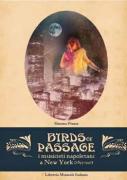Birds of passage. I musicisti napoletani e New York (1895-1940)

More than any other regional repertoire, Neapolitan song defined the Italian popular music tradition. From international celebrities like Enrico Caruso to the most middling small-town vedette, Neapolitan musicians transcended local identity and attracted new audiences by abandoning the operatic tendencies of Italian song, introducing new subjects, and embracing new musical trends like the foxtrot, blues, and tango. In this way, they helped to create one of the first modern examples of a truly transnational musical style. This lively history spans the years from Italian unification to the fascist regime of the early twentieth century to trace the transformation of songs written in regional dialect into a wildly popular art form recognized around the world.
As author Simona Frasca shows, the Neapolitan song tradition benefited from serendipitous historical circumstances: although they were forced to join the mass migration of Italians to New York and other American urban centres between 1880 and 1920, Neapolitan musicians managed to maintain strong ties with the art form's origins in Italy. By marrying a strong sense of tradition with an openness to new forms, these musicians helped to present a distinct form of 'Italianness' to the world even as they participated, along with other ethnic groups, to the production of 'American' identity.